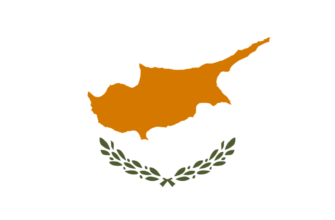Hong Kong is not a separate country, but a special administrative region within China. For more than 100 years the territory belonged to Great Britain and only in 1997 it was handed over again to the PRC. These events have left a noticeable imprint on politics and culture and are reflected in the young flag of Hong Kong.
This is what the modern flag of Hong Kong looks like:

History of the flag
Hong Kong came under British sovereignty after the First Opium War, which ended in 1842. From 1843, the local government officially used the British flag (Union Jack), and the first emblem of Hong Kong was introduced at the same time – a schematic representation of the port, where two local traders make a deal with a European in front of an English sailing boat and a traditional junk.

In 1868 the first banner with this emblem was issued, it was based on the British blue stern flag (blue cloth with the British flag in the upper left corner). But, the Governor of Hong Kong Richard McDonnell did not like this version, so in 1870 a new emblem appeared in the form of the abbreviation “HK” (Hong Kong) surmounted by a crown on a white background.

A British stern flag with a crown and the letters “HK” under it.
But this version did not last long either. In 1876 the old emblem of the trading port was returned to it, which existed unchanged until 1955, when it was artistically redesigned, making it more realistic.

From 1941 to 1945, the territory of Hong Kong was occupied by the Japanese army. During this period, only the banner of the Land of the Rising Sun was allowed to be used.
In 1959 the first official coat of arms of Hong Kong was presented to the Heraldic Chamber. The shield featured two red junks on the water and a golden crown, held by a crowned lion and a Chinese dragon, a stylized image of the island at the bottom, and another crowned lion with a ball in its paws at the top.
The modern banner, a white bauhinia flower (native plant Bauhinia blakeana) on a red background, was approved by China in 1990 and has been the official national, naval and civil flag since 1997.
The Basic Law of Hong Kong clearly regulates not only the appearance of the flag, but also the rules for its use. For example, it clearly spells out exactly when the flag must be raised and lowered, how it must hang (and stand) if used alone or in combination with the PRC flag, and on what days it must be lowered.
The ban on the use of the flag and emblem by any non-state organizations is also separately stipulated. Criminal penalties are foreseen for desecration or improper use of the flag.
The old colonial flag is still often used during protests by Hong Kong independence supporters.
Description
The flag is a red rectangular cloth with a height to width ratio of 2:3 and a white five-petaled bauhinia flower in the center. The flower is 0.6 in diameter and its petals diverge from the center, twisting clockwise. In the middle of each petal is a red five-pointed star, from which a line is drawn to the center of the flower. Together they resemble stylized stamens.
The law establishes eight standard sizes, the largest – 288x192cm, the smallest – 15x10cm. Production of flags different from the established standards is prohibited and threatens with confiscation of manufactured products and all used materials.
Colors
The red background of the Hong Kong flag is exactly the same shade as that used in the Chinese flag (the paint is called “Chinese red”). The image of the flower is completely white.
Meaning of colors and flag symbol
Red has been important to China since long before the Communist Party came to power. It is associated with celebration, triumph, success, and prosperity. In the flag of Hong Kong, this color symbolizes primarily its unity with the rest of China. The five stars on the petals of the flower, which echo the stars on the Chinese flag, have the same meaning.
The combination of red and white reflects Hong Kong’s position: although the area is once again part of China, it has a dual system of government. The flower itself harmonizes this duality.
General information about Hong Kong
| official language | Chinese and English |
| Capital | – |
| Territory | 1106.4 km2 |
| Population | 7 448 900 |
| Currency | Hong Kong dollar |
| Phone Code | +8 |









